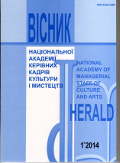STAINED GLASS WINDOWS WORKS IN INTERIORS OF KIEV SUBWAY AND FUNICULAR RAILWAY AND ITS PURPOSE IN FORMATION OF ARCHITECTURAL ENVIRONMENT
DOI:
https://doi.org/10.32461/2226-3209.1.2014.137920Keywords:
stained-glass window, monumental art, interior, architectureAbstract
The aim of the given article is the analysis of works of art of stained glass in interiors transport stations, identifying of stylistic features of stained glass windows and their role in shaping the built environment. Overall development of the art of stained glass of this period was marked by a trend towards non-traditional art-making, in accordance with contemporary architecture.
Surround stained with molten glass gained increasing popularity in the former Soviet Union and in the 70-80s of the twentieth century and became a popular artistic element in the complex interiors of public buildings and cultural sites of Kyiv. In search of new composite products and plastic image- making works of monumental glass artists are turning to new technologies, learn and implement in practice technological advances of Lithuanian stained-glass window makers.
Implementation of decorative pieces of stained glass for decoration of urban subway station and funicular stations required strict adherence to artists performance technologies and understanding of features of lighting in surroundings.
Contemporary technical capabilities allow use of stained glass cast longitudinal on end walls and facades, ceilings, floors and other architectural elements. Basic properties of stained glass art has also changed. There emerges main means of expression of stained volume of molten glass as such as colored stains ratio and overall tonal decisions.
During the development of the composition of the work the artist had to pay special attention to the following characteristics of the environment as monotonous repetition of architectural rhythm, static interiors, often limited to a closed space and alike.
Target synthesis of architecture and art thus determines the choice of form future monumental work or individual elements of decor station.
Analysis of the general stylistic direction and shaping features stained glass in interiors Kiev subway stations and cable car, can provide them into a separate group of monumental works of art and give the opportunity to trace the functional role of the stained glass windows in the organization of interior space, the relationship with the built environment.
Along with diverse artistic images of these objects also can be seen and excellent value of decorative stained glass for each architectural situation.
Examples of such monumental works can be seen on the Kiev Metro station – "Postal Square" (artist I.Levytska, 1976), "Pioneer" (now "Forest", artist I. Levitska, 1979), "Petrovka" (artists L. Semykyna, S. Baroyants, 1980). As you can see, contemporary stained glass window can exist in areas with lack of window openings. Aesthetic quality stained glass is no longer dependent on natural factors: season, time of day – the whole area of stained glass has a constant saturation and brightness. Sometimes traditional materials decorative monumental art in an enclosed underground station to the lack of light can lose their inherent expressive colors, textures, and other decorative features.
In this case, stained glass, artificially illuminated from the inside, is a winning position. Amidst the monotony of repetition a distinct architectural monumental work assumes a major role in the emotional perception of the interior. Of course, the use of artificial light allows tailoring the light most favorable to each individual product and emphasize their individual artistic qualities, but it eliminates the effect of stained glass living movement that create sunlight.
The monumental stained glass windows, designed for daylight is presented in the interiors of the upper and lower stations of Kiev funicular (artists V.Zadorozhnyy, M. Shkaraputa, 1984).
A common feature artwork above stations was stained using the technology of cast glass. Three-dimensional stained justified, especially in enclosed spaces underground stations with the ability to use artificial lighting, greater stability of the work to external adverse factors like. Art works in these specific interiors are designed to accentuate and complement the architectural structure of the environment, to organize the interior space, combine architectural details and create a complete image. Thus, we see the formation of common features artistic and imaginative solutions stained glass above objects: Priority architectural planning and transformation stained with individual object monumental decorative art in a constructive part of the overall design solution environment.
The above stained glass style combines common image-plastic solutions: conventional interpretation of images, symbolism and decorative compositions, local color and so on. Image of abstract symbolic simplification, decorative, using stylized natural forms. In the above situations, architectural stained glass cast act as decoration and structural element of the room. The main factor in choosing the composition and technological solutions monumental work from bulk glass composition is subordinate features of plant architecture, organic combination of internal space, support the general emotional state in the middle of the room, emphasizing the functionality of the building. Research stained glass in interiors of passenger Kiev subway stations and cable car stations opens perspectives for further work art analysis Kiev artists monumental art.
Downloads
Published
Issue
Section
License
Authors who publish with this journal agree to the following terms:
1. Authors retain copyright and grant the journal right of first publication with the work simultaneously licensed under a Creative Commons Attribution License International CC-BY that allows others to share the work with an acknowledgement of the work's authorship and initial publication in this journal.
2. Authors are able to enter into separate, additional contractual arrangements for the non-exclusive distribution of the journal's published version of the work (e.g., post it to an institutional repository or publish it in a book), with an acknowledgement of its initial publication in this journal.
3. Authors are permitted and encouraged to post their work online (e.g., in institutional repositories or on their website) prior to and during the submission process, as it can lead to productive exchanges, as well as earlier and greater citation of published work (See The Effect of Open Access).


